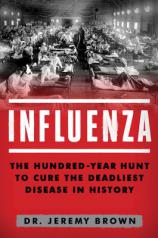Influenza: The Hundred-Year Hunt to Cure the Deadliest Disease in History
Review
Influenza: The Hundred-Year Hunt to Cure the Deadliest Disease in History
Most people are aware of the epidemic of Spanish flu that killed millions worldwide in 1918. Now a hundred years have passed, and the best information we have, according to research physician Jerry Brown, indicates that we are not much closer to finding a cure for the flu, or predicting and coping with a massive outbreak, than we were a century ago.
Beginning with a harrowing story of a modern flu victim to illustrate how devastating “just the flu” can still be, Brown then takes us back to 1918, when two wars were being waged: World War I and the fight against the flu. The latter was especially significant since conditions for the disease’s spread were ideal: the virus needs live cells to do its dirty work, and to find live cells it needs crowds. Those in uniform in crowded barracks were susceptible, along with the poor, crammed into tenements with many family members occupying a tiny space. Add to that the virus’s “shapeshifting” capabilities, which explain why we may get the flu more than once in a season (usually, Brown says, a winter period of low to no sunlight).
"Beginning with a harrowing story of a modern flu victim to illustrate how devastating 'just the flu' can still be, Brown then takes us back to 1918, when two wars were being waged: World War I and the fight against the flu."
In 1918, people, including medical providers, relied on ineffective or fatal remedies such as bloodletting, gas inhalation and overdosing on aspirin. A disturbing chart offered by Brown depicts the average life expectancy in 1918 --- around 40 --- as compared to the pre-1918 flu rate of 55 and the gradual rise to 70 by 1960.
Yet, as Brown points out, some survive the flu. But despite studies that have included such extremes as digging up the frozen bodies of flu victims in Alaska and elsewhere, little is known about how to stop the virus from jumping off birds and swine and hopping onto people. It still kills about 30,000 Americans each year.
Brown, the Director of Emergency Care Research at the National Institutes of Health, avers that there is still no drug that eradicates the virus, and added to the problem are anti-viral drugs that are efficacious at creating controversy, as none seems to work, or to work every year, or in all cases. Brown believes that by forgetting the ravages of the 1918 epidemic, we may be doomed to have a repeat: “Marking its centennial is a step in the right direction, but it’s a very small step.” He’s calling for a 1918 "flu memorial" and hopes that by the time it’s built, “we will also be celebrating a cure.”
Reviewed by Barbara Bamberger Scott on December 14, 2018
Influenza: The Hundred-Year Hunt to Cure the Deadliest Disease in History
- Publication Date: December 18, 2018
- Genres: Health, History, Nonfiction
- Hardcover: 272 pages
- Publisher: Touchstone
- ISBN-10: 1501181246
- ISBN-13: 9781501181245




